[caption id="attachment_1618" align="alignleft" width="225" caption="not quite fly agaric"]
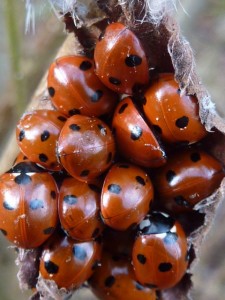
[/caption]
Serried timber trees, broad trunked with fly agaric mushrooms poking through dead leaves. Why is this the popular image of a wood? Should we blame Racey Helps or Beatrix Potter? Apparently not. According to Oliver Rackham, (the historian of the English countryside) this woodland askew view is to be blamed on the “scientists and savants of the Enlightenment”.
And so to put things right in my own mind, at least, I took myself on a day out. Yesterday I went out into the hazel wood with Angus. Two woods in fact. Both ancient and under proper conservation management. Angus has taken them both on.
The first is owned by a foreign consortium who leave him to work the woods, apply for grants, liaise with the gamekeeper and pay for his time with the sale of firewood. The second wood is on a farm nearby. The farmer has turned over his acreage to conservation. Ponds have been cleaned of bramble and bullrush, corners of fields returned to meadow and strips of crops to yield birdseed planted in 8 of the fields. We walked up and sent a flurry of buntings into the sky.
[caption id="attachment_1622" align="alignleft" width="225" caption="young hazel coppice regrowth"]
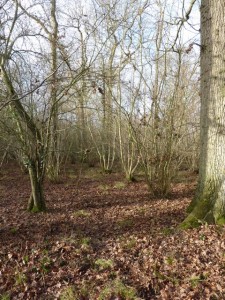
[/caption]
Old woods have been vigorously worked down the centuries on a cycle of coppicing. This means that deciduous species such as hazel, ash and the like are cut down every 15 to 20 years for firewood and hazel rods for thatching and hurdling. They make an under storey under the big trees. The latter, growing away to timber (house-building size) should only take up 20 percent of the allotted space and not drown out all the light from the underlings. These underlings are close-planted to draw them skywards, yielding good straight stems. The art of coppicing is simple: fell the tree pretty much to ground level if it is a hazel. Ash, equally common, is cut down to about 40 cms off the ground. This leaves a hoary stump providing a habitat for insects and birds.
The cutting to the ground encourages strong regrowth from the basal stem of the tree called a "stool". In areas of old wood pasture with grazing cattle 'pollarding' was the preferred cut. In other words, the trunk cut for the branches to regrow above browsing height. Treated like this, the trees far out span the life of a standard. Human interference regenerates. Deciduous woodland, felled in cycle to provide firewood and other coppice products is often ancient, with records going back to the 12th century and earlier.
[caption id="attachment_1623" align="alignleft" width="300" caption="new hazel stool"]
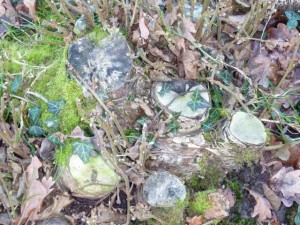
[/caption]
Such woods will have very large stools from previous felling and quite often a ditch or bank which at the time of digging would have been a mighty earthwork de-marking land ownership. One strong clue to age is the mix of flowers and ground carpeting perennials. There is a matrix of flora that is confined to ancient woodland by lack of efficient means of seed dispersal. Plants like dogs mercury, wild garlic, oxlip, and cow wheat establish by clonal means very slowly. Or seeds are moved about by ants and not very far. The coppicing cycle opens up shafts of sunlight, warms dormant seeds. Modern woodlands are just too shady.
[caption id="attachment_1615" align="alignleft" width="480" caption="brash to deter deer"]
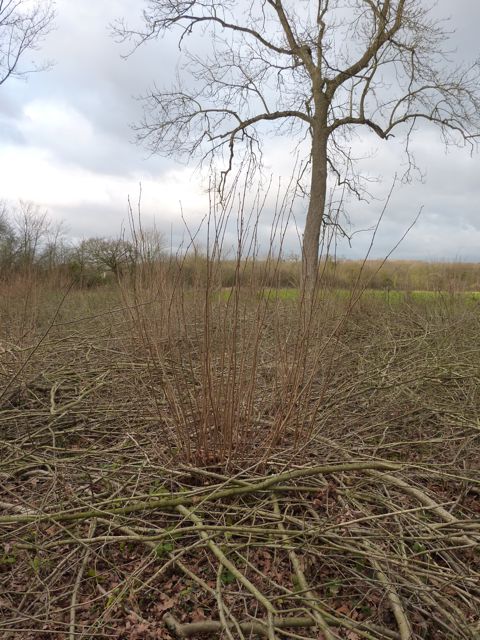
[/caption]
A wood is divided into patches of roughly one acre, to be felled in turn year by year over the winter months. Firewood is logged and stacked to season and dry out. The brash (unwanted side stems and branches) is piled over the newly hewn stumps. It is a way of fire-fighting deer damage. Bambi is number one public enemy. New coppice growth is munched, bigger branches rubbed raw by antlers and the carpet of woodland flowers browsed to extinction. Deer numbers are on the up. The richness of the wood is under attack, diminished. Any means of keeping the mixed deer population (red, roe, fallow, muntjac and Chinese water deer) down has to be encouraged.
Angus works the woods in winter. He is sensitive to their good and long term health. Tractors have been banished for the damage to the soil from heavy tyres: spraying wet mud sideways and creating bubbling pools of liquid clay. The most remorseless quagmires have been filled with old logs and timber to level and dry out the land. A learning curve for the gamekeeper who has had to take to walking through the woods.
In the drier summer months he weaves hurdles from split hazel rods. Sometimes this is supplied by weaving a fencing line in situ. He is also a master of the craft of laying a hedge. This is where the main trunks of a grown out straggly old hedge are practically severed towards the bases and laid on their side. New growth is stimulated the whole way up the trunk, encouraging bushiness and regeneration. A stock-proof fence is remade by these means. Working the landscape with the skills keeps it young and lively. Perhaps Angus too. He doesn't seem to have aged in the 15 years since I first met him.
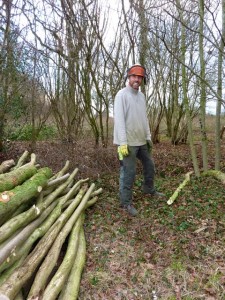
Is the secret elixir to wield a chainsaw, kevlar-clad in the wet and dripping woodlands? Perhaps not, but he gave up a career he hated in industrial design and lives by thoughtful ground rules. Topped up by a great deal of bicycling. I had lost touch with him as he had moved house. Tracking down a man with no mobile telephone, email or internet connection and no forwarding address could be tricky. But I googled his name and up flashed a sheaf of champion cycling wins.
"You couldn't pay a mortgage doing this work." He is lucky that his partner has a regular salaried job, where he is reliant on wood sales. "I have got one other friend who does this for a living and he lives in a caravan".
It looks to me like wood sales might go up steadily with oil price hikes and it would be cool to see this fantastic art of a job become a little more remunerative.
 [/caption]
Serried timber trees, broad trunked with fly agaric mushrooms poking through dead leaves. Why is this the popular image of a wood? Should we blame Racey Helps or Beatrix Potter? Apparently not. According to Oliver Rackham, (the historian of the English countryside) this woodland askew view is to be blamed on the “scientists and savants of the Enlightenment”.
And so to put things right in my own mind, at least, I took myself on a day out. Yesterday I went out into the hazel wood with Angus. Two woods in fact. Both ancient and under proper conservation management. Angus has taken them both on.
The first is owned by a foreign consortium who leave him to work the woods, apply for grants, liaise with the gamekeeper and pay for his time with the sale of firewood. The second wood is on a farm nearby. The farmer has turned over his acreage to conservation. Ponds have been cleaned of bramble and bullrush, corners of fields returned to meadow and strips of crops to yield birdseed planted in 8 of the fields. We walked up and sent a flurry of buntings into the sky.
[caption id="attachment_1622" align="alignleft" width="225" caption="young hazel coppice regrowth"]
[/caption]
Serried timber trees, broad trunked with fly agaric mushrooms poking through dead leaves. Why is this the popular image of a wood? Should we blame Racey Helps or Beatrix Potter? Apparently not. According to Oliver Rackham, (the historian of the English countryside) this woodland askew view is to be blamed on the “scientists and savants of the Enlightenment”.
And so to put things right in my own mind, at least, I took myself on a day out. Yesterday I went out into the hazel wood with Angus. Two woods in fact. Both ancient and under proper conservation management. Angus has taken them both on.
The first is owned by a foreign consortium who leave him to work the woods, apply for grants, liaise with the gamekeeper and pay for his time with the sale of firewood. The second wood is on a farm nearby. The farmer has turned over his acreage to conservation. Ponds have been cleaned of bramble and bullrush, corners of fields returned to meadow and strips of crops to yield birdseed planted in 8 of the fields. We walked up and sent a flurry of buntings into the sky.
[caption id="attachment_1622" align="alignleft" width="225" caption="young hazel coppice regrowth"] [/caption]
Old woods have been vigorously worked down the centuries on a cycle of coppicing. This means that deciduous species such as hazel, ash and the like are cut down every 15 to 20 years for firewood and hazel rods for thatching and hurdling. They make an under storey under the big trees. The latter, growing away to timber (house-building size) should only take up 20 percent of the allotted space and not drown out all the light from the underlings. These underlings are close-planted to draw them skywards, yielding good straight stems. The art of coppicing is simple: fell the tree pretty much to ground level if it is a hazel. Ash, equally common, is cut down to about 40 cms off the ground. This leaves a hoary stump providing a habitat for insects and birds.
The cutting to the ground encourages strong regrowth from the basal stem of the tree called a "stool". In areas of old wood pasture with grazing cattle 'pollarding' was the preferred cut. In other words, the trunk cut for the branches to regrow above browsing height. Treated like this, the trees far out span the life of a standard. Human interference regenerates. Deciduous woodland, felled in cycle to provide firewood and other coppice products is often ancient, with records going back to the 12th century and earlier.
[caption id="attachment_1623" align="alignleft" width="300" caption="new hazel stool"]
[/caption]
Old woods have been vigorously worked down the centuries on a cycle of coppicing. This means that deciduous species such as hazel, ash and the like are cut down every 15 to 20 years for firewood and hazel rods for thatching and hurdling. They make an under storey under the big trees. The latter, growing away to timber (house-building size) should only take up 20 percent of the allotted space and not drown out all the light from the underlings. These underlings are close-planted to draw them skywards, yielding good straight stems. The art of coppicing is simple: fell the tree pretty much to ground level if it is a hazel. Ash, equally common, is cut down to about 40 cms off the ground. This leaves a hoary stump providing a habitat for insects and birds.
The cutting to the ground encourages strong regrowth from the basal stem of the tree called a "stool". In areas of old wood pasture with grazing cattle 'pollarding' was the preferred cut. In other words, the trunk cut for the branches to regrow above browsing height. Treated like this, the trees far out span the life of a standard. Human interference regenerates. Deciduous woodland, felled in cycle to provide firewood and other coppice products is often ancient, with records going back to the 12th century and earlier.
[caption id="attachment_1623" align="alignleft" width="300" caption="new hazel stool"] [/caption]
Such woods will have very large stools from previous felling and quite often a ditch or bank which at the time of digging would have been a mighty earthwork de-marking land ownership. One strong clue to age is the mix of flowers and ground carpeting perennials. There is a matrix of flora that is confined to ancient woodland by lack of efficient means of seed dispersal. Plants like dogs mercury, wild garlic, oxlip, and cow wheat establish by clonal means very slowly. Or seeds are moved about by ants and not very far. The coppicing cycle opens up shafts of sunlight, warms dormant seeds. Modern woodlands are just too shady.
[caption id="attachment_1615" align="alignleft" width="480" caption="brash to deter deer"]
[/caption]
Such woods will have very large stools from previous felling and quite often a ditch or bank which at the time of digging would have been a mighty earthwork de-marking land ownership. One strong clue to age is the mix of flowers and ground carpeting perennials. There is a matrix of flora that is confined to ancient woodland by lack of efficient means of seed dispersal. Plants like dogs mercury, wild garlic, oxlip, and cow wheat establish by clonal means very slowly. Or seeds are moved about by ants and not very far. The coppicing cycle opens up shafts of sunlight, warms dormant seeds. Modern woodlands are just too shady.
[caption id="attachment_1615" align="alignleft" width="480" caption="brash to deter deer"] [/caption]
A wood is divided into patches of roughly one acre, to be felled in turn year by year over the winter months. Firewood is logged and stacked to season and dry out. The brash (unwanted side stems and branches) is piled over the newly hewn stumps. It is a way of fire-fighting deer damage. Bambi is number one public enemy. New coppice growth is munched, bigger branches rubbed raw by antlers and the carpet of woodland flowers browsed to extinction. Deer numbers are on the up. The richness of the wood is under attack, diminished. Any means of keeping the mixed deer population (red, roe, fallow, muntjac and Chinese water deer) down has to be encouraged.
Angus works the woods in winter. He is sensitive to their good and long term health. Tractors have been banished for the damage to the soil from heavy tyres: spraying wet mud sideways and creating bubbling pools of liquid clay. The most remorseless quagmires have been filled with old logs and timber to level and dry out the land. A learning curve for the gamekeeper who has had to take to walking through the woods.
In the drier summer months he weaves hurdles from split hazel rods. Sometimes this is supplied by weaving a fencing line in situ. He is also a master of the craft of laying a hedge. This is where the main trunks of a grown out straggly old hedge are practically severed towards the bases and laid on their side. New growth is stimulated the whole way up the trunk, encouraging bushiness and regeneration. A stock-proof fence is remade by these means. Working the landscape with the skills keeps it young and lively. Perhaps Angus too. He doesn't seem to have aged in the 15 years since I first met him.
[/caption]
A wood is divided into patches of roughly one acre, to be felled in turn year by year over the winter months. Firewood is logged and stacked to season and dry out. The brash (unwanted side stems and branches) is piled over the newly hewn stumps. It is a way of fire-fighting deer damage. Bambi is number one public enemy. New coppice growth is munched, bigger branches rubbed raw by antlers and the carpet of woodland flowers browsed to extinction. Deer numbers are on the up. The richness of the wood is under attack, diminished. Any means of keeping the mixed deer population (red, roe, fallow, muntjac and Chinese water deer) down has to be encouraged.
Angus works the woods in winter. He is sensitive to their good and long term health. Tractors have been banished for the damage to the soil from heavy tyres: spraying wet mud sideways and creating bubbling pools of liquid clay. The most remorseless quagmires have been filled with old logs and timber to level and dry out the land. A learning curve for the gamekeeper who has had to take to walking through the woods.
In the drier summer months he weaves hurdles from split hazel rods. Sometimes this is supplied by weaving a fencing line in situ. He is also a master of the craft of laying a hedge. This is where the main trunks of a grown out straggly old hedge are practically severed towards the bases and laid on their side. New growth is stimulated the whole way up the trunk, encouraging bushiness and regeneration. A stock-proof fence is remade by these means. Working the landscape with the skills keeps it young and lively. Perhaps Angus too. He doesn't seem to have aged in the 15 years since I first met him.
 Is the secret elixir to wield a chainsaw, kevlar-clad in the wet and dripping woodlands? Perhaps not, but he gave up a career he hated in industrial design and lives by thoughtful ground rules. Topped up by a great deal of bicycling. I had lost touch with him as he had moved house. Tracking down a man with no mobile telephone, email or internet connection and no forwarding address could be tricky. But I googled his name and up flashed a sheaf of champion cycling wins.
"You couldn't pay a mortgage doing this work." He is lucky that his partner has a regular salaried job, where he is reliant on wood sales. "I have got one other friend who does this for a living and he lives in a caravan".
It looks to me like wood sales might go up steadily with oil price hikes and it would be cool to see this fantastic art of a job become a little more remunerative.
Is the secret elixir to wield a chainsaw, kevlar-clad in the wet and dripping woodlands? Perhaps not, but he gave up a career he hated in industrial design and lives by thoughtful ground rules. Topped up by a great deal of bicycling. I had lost touch with him as he had moved house. Tracking down a man with no mobile telephone, email or internet connection and no forwarding address could be tricky. But I googled his name and up flashed a sheaf of champion cycling wins.
"You couldn't pay a mortgage doing this work." He is lucky that his partner has a regular salaried job, where he is reliant on wood sales. "I have got one other friend who does this for a living and he lives in a caravan".
It looks to me like wood sales might go up steadily with oil price hikes and it would be cool to see this fantastic art of a job become a little more remunerative. 